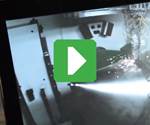CGTech Extends Simulation to Thermwood LSAM (Includes Video)
Large-scale additive manufacturing platform is the largest 3D printer yet simulated. Watch video for example of how simulation using program G-code catches an error that would otherwise lead to a failed build.

This part, which fills the build height of the LSAM machine, took about 16 hours to 3D print. Build failure potentially wastes not just time on a large-format 3D printer, but also a lot of material. Simulation protects against this, as described in the article and video below.
A part made through material deposition on a very large 3D printer potentially requires not just considerable material and machine travels, but also a large program file. To build a part that fills much of the 10 × 20 × 5 foot build volume of just the standard, midsize version of Thermwood’s Large-Scale Additive Manufacturing (LSAM) machine for carbon-fiber-reinforced polymer 3D printing could easily require hundreds of thousands of lines of G-code programming. That is why it’s significant that CGTech has recently introduced simulation capabilities developed in partnership with Thermwood for this line of machines. CGTech is the maker of Vericut software for simulating machining and additive manufacturing processes, and product manager Gene Granata says the LSAM is the largest 3D printer the company has simulated yet.
Size makes the simulation all the more valuable. Vericut is like an “insurance policy,” Granata says. This measure recognizes that, for one reason or another, the posted program might not be perfect. Evaluating the program by giving it a trial run using a digital twin can catch errors in minutes that might compromise the build if discovered during printing, costing wasted material and hours of lost machine time. It can even protect the machine in cases where simulation catches a move that in real life would lead to a crash.

The CGTech simulation executes the same G code the physical machine will. The simulation truly aims to be a digital twin, not just for the machine but also for the process. The software essentially models gravity, too, because additive requirements such as support for overhangs is also part of the simulation.
Importantly, the CGTech simulation executes the posted G-code programming as the machine would. This is why the involvement of the machine maker is required. On the LSAM system, there are G-code commands meaningful only to this machine. “We have over 55 patented features (and over a dozen more pending) that set the LSAM apart from any other large-scale additive system available today,” says Dennis Palmer, Thermwood’s VP of sales. One of those features is an altogether different orientation for printing, the vertical layer printing system. CGTech can simulate the machine’s 3D printing in its various modes, and can also continue into simulating the machining steps that follow on versions of this large 3D printer offering hybrid additive/subtractive capability.
Accurate digital definition of the machine is coupled to digital simulation of the deposition process and its needs. Granata says not just the machine motion is simulated, but also the part resulting from the deposition rate of the material.
I recently spoke to him about the LSAM simulation. He shared an example in which simulation detected a condition of excess overhang. Watch the video:
Related resources:
Related Content
3 Unique Elements of LFAM to Consider in Design
While similar to desktop fused filament fabrication (FFF), large format additive manufacturing (LFAM) in polymer composite poses several unique challenges as a result of its scale.
Read More3D Printed Human-Operated End-of-Arm Tooling Promotes Safety and Throughput
Toolmaker and injection molder Zero Tolerance developed a manual tool to enable an operator to quickly place inserts into a mold.
Read MoreTo Improve Performance of Compression Molded Composites, Add 3D Printed Preforms
9T Labs' Additive Fusion Technology enables the manufacture of composite structures with as much or as little reinforcement as is necessary, using 3D printed continuous fiber preforms to add strength just where needed.
Read More3D Printed Preforms Improve Strength of Composite Brackets: The Cool Parts Show Bonus
On this episode, we look at a pin bracket for the overhead bin of an airplane made in two composite versions: one with continuous fiber 3D printed reinforcements plus chopped fiber material, and one molded from chopped fiber alone.
Read MoreRead Next
Video: 3 Roles for Simulation in Additive Manufacturing
This conversation with PADT’s Eric Miller explores how simulation and 3D printing work together at three distinct stages in additive manufacturing, for DFAM and beyond.
Read MoreVideo: How Simulation Assists Directed Energy Deposition
Scrapping an AM part is potentially as costly as scrapping a machined part. Directed energy deposition is an additive process that can benefit from a resource that safeguards machining: simulation software.
Read MoreThermwood’s Vertical Layer Printing Turns AM on Its Side
Vertical Layer Printing (VLP) 3D prints layers perpendicular to the floor, extending Z height to the length of the print bed — as long as 40 feet.
Read More




















